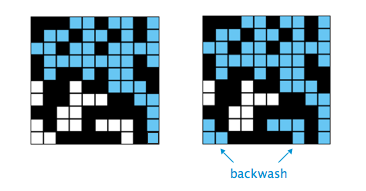% java PercolationVisualizer < input10.txt

|
|
What are the goals of this assigment?
What's a checklist? The assignment checklists are meant to supplement the assignment, clearing up any potentially confusing points and providing some hints.
Is there anything else I should do before getting started? Please read the Assignments Page, including the collaboration policy, lateness policy, and submission system instructions if you have not done so already.
What Java programming environment should I use? You are free to choose your own. We recommend DrJava and the command-line, which is what most of you used in COS 126. For instruction, go to the first paragraph of Section 1.1 of Introduction to Programming in Java. You will also need to use the Terminal (OS X) or Command Prompt (Windows) on your system. You can review how to do this in Section 1.5.
Where can I learn about the standard input and output libraries that are used in this course? You should be familiar with them already if you took COS 126. If you placed out of COS 126, they are described in Section 1.5 and Section 2.2 of Introduction to Programming in Java booksite. Here are the APIs. Note that there is a DrJava bug that prevents StdIn.isEmpty() from returning true, so you must use the Terminal (OS X) or Command Prompt (Windows) to execute PercolationVisualizer.
How should I format and comment my code? Here are some recommended style guidelines. Below are some that are particularly important (and you will lose points if you ignore).
How long should my program be? You should strive for clarity and efficiency. Our reference solution for Percolation.java is about 70 lines, plus a test client. Our clients are about 50 lines each.
After the system has percolated, my PercolationVisualizer colors in cyan all sites connected to open sites on the bottom (in addition to those connected to open sites on the top). Is this backwash OK? Yes, we won't deduct for that. You can think of the water as filling back up from the bottom.
% java PercolationVisualizer < input10.txt
How efficient should the methods in Percolation be? The construction should take N^2 time; the other methods should take time at most logarithmic in N.
How do I generate a random blocked site? Pick a site at random (by using StdRandom to generate two integers between 1 and N) and use this site if it is blocked; if not, repeat.
I don't get reliable timing information for when N is 200. What should I do? Increase the size of N (say to 400, 800, and 1600), until mean running time exceeds the standard deviation of the running time.
My program is getting overly-complicated because I'm re-implementing the union-find data structure, specializing it to an N-by-N grid of objects. Am I on the right track? No, you are re-inventing the wheel. Instead, use the Quick* files from lecture as is. This design makes your code more modular and easier to understand.
Is it possible to perform one experiment in N^2 time? Yes, but you are not asked to discover the algorithm.
I'm curious. Where can I learn a bit more about the percolation model? Read Section 2.4 of Introduction to Programming in Java.
|
|
Submission. After you have submitted all of the required files, the "Run Script" button on the submission system will appear. Be sure to hit the button and check that you submitted the right files and they compile cleanly.
Readme. Use the following readme file template and answer all questions.
|
|
These are purely suggestions for how you might make progress. You do not have to follow these steps.